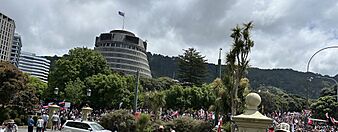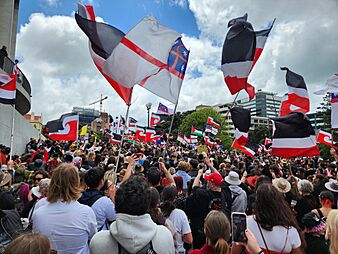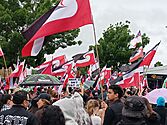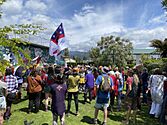Hīkoi mō te Tiriti facts for kids
Quick facts for kids Hīkoi mō te Tiriti |
|||
|---|---|---|---|
| Part of Māori protest movement | |||
|
From top, left to right:
Crowds surround the Beehive, protesters on the forecourt of Parliament, marchers in Hastings, group in Tākaka |
|||
| Date | 10–19 November 2024 | ||
| Location | |||
| Caused by | Opposition to changes to the principles of the Treaty of Waitangi as put forth in the Treaty Principles Bill | ||
| Methods | Hīkoi marches, demonstration at Parliament House, haka | ||
| Parties to the civil conflict | |||
|
|||
| Lead figures | |||
|
|||
| Number | |||
|
|||
The Hīkoi mō te Tiriti (pronounced Hee-koy moh teh Tee-ree-tee) was a series of big protests in New Zealand. "Hīkoi" means "march" or "walk" in the Māori language, and "mō te Tiriti" means "for the Treaty." These marches happened from November 10 to November 19, 2024. People were protesting against a new law called the Treaty Principles Bill. This bill aimed to change how the Treaty of Waitangi is understood and used in New Zealand.
Contents
Understanding the Hīkoi Mō Te Tiriti Protests
The Hīkoi mō te Tiriti protests were a major event in New Zealand. Thousands of people marched to show their feelings about a new proposed law. These marches were a way for people to stand up for what they believed in.
What is the Treaty of Waitangi?
The Treaty of Waitangi is a very important agreement in New Zealand's history. It was signed in 1840 between the British Crown (the government of Britain) and many Māori chiefs. The Treaty set out how Māori and European settlers would live together in New Zealand.
Over time, different ideas have come up about what the Treaty means. These ideas are often called the "principles" of the Treaty. They help guide how the Treaty is used today in New Zealand's laws and government.
Why Did the Protests Happen?
The protests happened because of a new law called the Treaty Principles Bill. This bill was introduced in November 2024 by the government. The main idea behind the bill was to change the "principles" of the Treaty of Waitangi.
David Seymour, who leads the ACT New Zealand political party, introduced the bill. He believed the original Treaty did not clearly define the rights of all New Zealanders. He wanted the new bill to make sure everyone had equal rights, no matter their background.
Who Supported and Opposed the Bill?
The Treaty Principles Bill caused a lot of debate. Many groups were against it, including:
- Senior lawyers
- Opposition political parties like Te Pāti Māori, the Labour Party, and the Green Party
- Supporters of Māori rights
These groups argued that the bill would weaken Māori rights. They also felt that the government did not talk enough with Māori communities before introducing the bill.
On the other side, supporters of the bill, like ACT New Zealand, said it would make sure all New Zealanders have equal rights. The other two parties in the government, National and New Zealand First, did not fully support the bill. They said they would vote against it later on.
The Marches Across New Zealand
The Hīkoi mō te Tiriti marches took place all over New Zealand. People walked from different parts of the country towards the capital city, Wellington.
Before the marches reached Wellington, more than 20,000 people had already joined in. When the Hīkoi arrived in Wellington, about 42,000 people marched in the city. Important people, including politicians and the Māori Queen, Ngā Wai Hono i te Pō, joined the march in Wellington.
During the protests, Members of Parliament even performed a haka (a traditional Māori dance and challenge) in the House of Representatives. This action delayed the first reading of the bill in Parliament.
See also
 In Spanish: Hīkoi mō te Tiriti para niños
In Spanish: Hīkoi mō te Tiriti para niños
- Māori protest movement
- Māori land march
- 2022 Wellington protest





